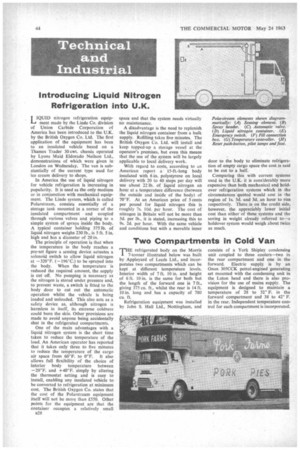Introducing Liquid Nitrogen Refrigeration into U.K.
Page 46

If you've noticed an error in this article please click here to report it so we can fix it.
LIQUID nitrogen refrigeration equipment made by the Linde Co. division of Union Carbide Corporation of America has been introduced to the U.K. by the British Oxygen Co. Ltd. The first application of the equipment has been to an insulated vehicle based on a Thames Trader 30 cwt. chassis operated by Lyons Maid Eldorado Neilson Ltd., demonstrations of which were given in London on Wednesday. The van is substantially of the current type used for -ice cream delivery to shops.
In America the use of liquid nitrogen for vehicle refrigeration is increasing in popularity. It is used as the only medium or in conjunction with mechanical equipment. The Linde system, which is called Polarstream, consists essentially of a storage tank mounted in a corner of the insulated compartment and coupled through various valves and piping to a simple system of sprays inside the body. A typical container holding 375 lb. of liquid nitrogen weighs 230 lb., is 5 ft. 5 in. high and has a diameter of 20 in.
The principle of operation is that when the temperature in the body reaches a pre-set figure a sensing device actuates a solenoid switch to allow liquid nitrogen at —320°F. (-196°C.) to be sprayed into the body. When the temperature is reduced the required amount, the supply is cut off. No pumping is necessary as the nitrogen is stored under pressure and, to prevent waste, a switch is fitted to the body door to cut out the automatic operation whilst the vehicle is being loaded and unloaded. This also acts as a safety device as, although nitrogen is harmless in itself, its extreme coldness could burn the skin. Other provisions are made to avoid anyone being accidentally shut in the refrigerated compartments.
One of the main advantages with a liquid nitrogen system is the short time taken to reduce the temperature of the load. An American operator has reported that it takes only three to five minutes to reduce the temperature of the cargo air space from 60°F. to 0°F_ It also allows full flexibility of the choice of interior body temperature between —20°F. and +40°F. simply by altering the thermostat setting and is easy to install, enabling any insulated vehicle to be converted to refrigeration at minimum cast. The British Oxygen Co. states that the cost of the Polarstrcam equipment itself will not be more than £550. Other points for the equipment are that the container occupies a relatively small
n28 space and that the system needs virtually no maintenance.
A disadvantage is the need to replenish the liquid nitrogen container from a bulk supply. Refilling takes five minutes. The British Oxygen Co. Ltd. will install and keep topped-up a storage vessel at the operator's premises, but even this means that the use of the system will be largely applicable to local delivery work.
With regard to costs, according to an American report a 15-ft.-long body insulated with 6 in. polystyrene on local delivery with 20 to 40 stops per day will use about 22 lb. of liquid nitrogen an hour at a temperature difference (between the outside and inside of the body) of 70°F. At an American price of 5 cents per pound for liquid nitrogen this is roughly 7s. 10d. per hour. The cost of nitrogen in Britain will not be more than 5d. per lb., it is stated, increasing this to 9s. 2d. per hour. With the same vehicle and conditions but with a movable inner door to the body to eliminate refrigeration of empty cargo space the cost is said to be cut to a half.
Comparing this with current systems used in the U.K. it is consilerably more expensive than both mechanical and holdover refrigeration systems which in the circumstances quoted would cost in the region of Is. 3d. and 3d. an hour to run respectively. There is on the credit side, however, the appreciably lower initial cost than either of these systems and the saving in weight already referred to—a holdover system would weigh about twice as much.
















































































































